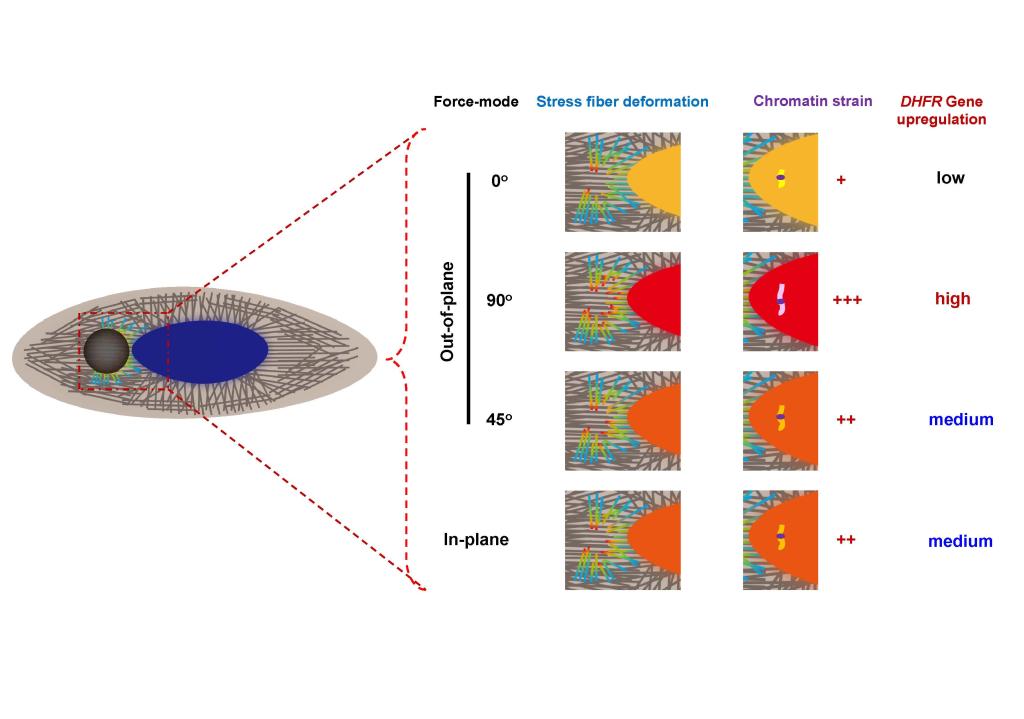On September 29, 2020, an original article entitled “Stress fiber anisotropy contributes to force-mode dependent chromatin stretching and gene upregulation in living cells” has been published at Nature Communications (IF=12.121), which was led by Dr. Fuxiang Wei (first author and co-corresponding author) at College of Life Science and Technology of Huazhong University of Science and Technology. In this study, live cell experiments and theoretical modeling using discrete anisotropic stress fibers reveal the observation and underlying mechanisms of force-mode dependence in gene expression.
Heart and blood vessels experience various complex modes of physical forces such as shear stress generated by blood flow and tensile stress generated by blood pressure. Complex diseases such as cardiovascular diseases and cancer are closely related to mechanical signals at cellular and tissue levels. However, how the cells perceive different modes of force is elusive. Increasing evidence demonstrates that mechanical signals and chemical signals play important roles in determining cell behaviors and functions. Compared with chemical signals, mechanical signals are directional and are transmitted much faster inside the cells. How to quantify the effects of mechanical forces in real time in living cells has been a challenge for years in the field of mechanobiology. During his PhD study, Dr. Wei sets up a platform that combines the STED (stimulated emission depletion) microscope with the three-dimensional magnetic twisting cytometry (3D-MTC) which measures the cellular responses of mechanical forces in real time. Using this technology, they found that the force can be transmitted from the cell surface to the nucleus via the cytoskeleton and directly stretches the chromatin and induces gene upregulation. These studies were published at Nature Materials in 2016 and at Nature Protocols in 2017. Top journal such as Science, Nature Materials, and Nature Reviews Molecular Cell Biology reported these breakthroughs.
Recently Dr. Wei led a research team to work on cellular responses to different modes of force. They used 3D-MTC to apply the different modes of force via an magnetic bead attached to the cell surface via integrin. They applied the force either via the out-of-plane modes: along the long axis of the cell, the short axis of the cell, or the bisector of long axis and short axis of the cell, or the in-plane mode, which mostly generates shear stress on the cell surface. Force of the same amplitude but different modes leads to different deformation maps in the cell and induces various degrees of chromatin stretching.

Figure: Force of the same amplitude but different modes leads to different strain distribution in the cell and directly stretches the chromatin to activate gene expression to different degrees. In-plane force mode mostly generates shear stress and out-of-plane force modes generates normal stresses. This figure is changed from Wei F et al. in Nature Communications.
Dr. Wei et al. then find that the gene expression was positively associated with chromatin stretching. Inhibiting prestress of actin stress fibers decreases cell stiffness, chromatin stretching, and gene upregulation. Completely disrupting actin stress fibers abolishes cell stiffness anisotropy, chromatin deformation, and gene upregulation. Theoretical modeling reveals that actin stress fiber is the key factor for the cell to respond to different modes of force.
Mechanomedicine is an emerging subfield of biomechanics and mechanobiology proposed by Prof. Ning Wang at University of Illinois in 2009. It was based on the fundamental principles of mechanics and engineering to develop new techniques and methods that can be applied in vitro and in vivo toward the goal of early diagnosis, treatment, and cure of complex diseases. In 2012, the American Biomedical Engineering Society (BMES) identifies Mechanomedicine as a new area in biomedical engineering. This emerging field is a branch of biomechanics and mechanobiology, pioneered in the early 1960s by the late Prof. Yuan-Cheng Fung, founding father of modern biomechanics.
In 2012, collaborating with Professor Bo Huang of the Chinese Academy of Medical Sciences and Tongji Medical College, Professor Junwei Chen, director of the Laboratory of Cellular Biomechanics and Regenerative Medicine at College of Life Sciences and Technology, developed an efficient method for selecting and isolating malignant tumor repopulating cells. They found the low stiffness and low force facilitate tumor repopulating cell survival and growth (the work was published in Nature Materials in 2012). Later they discovered that Sox2 (a self-renewing gene) was the key factor for tumor repopulating cells metastasis and self-renew (the work was published in Nature Communications in 2014). After that, Prof. Chen collaborated with Prof. Biao Yu at Shanghai Institute of Organic Chemistry of the Chinese Academy of Sciences to synthesize a small molecule called WYC209. This molecule specifically inhibits tumor repopulating cells in malignant tumors in vitro and in vivo. They published the work in Nature Communications in 2018. In 2020, they collaborate with Professor Ning Wang of University of Illinois and reveal that demethylation levels of histone H3K9 are a key factor that directly regulates the gene upregulation by force. This work is published in Science Advances. Professor Chen leads these important discoveries that are pioneering works in the field of Mechano-onco-medicine.
The co-first authors of this article including Cunyu Zhang and Yawen Liao who are 2017 master degree graduates from College of Life Science and Technology at HUST and Xiangyu Xu, a PhD candidate of Beijing Institute of Technology supervised by Prof. Ji. The co-corresponding authors were Prof. Baohua Ji of Zhejiang University and Endowed Chair Prof. Ning Wang of University of Illinois Urbana-Champaign.
Link of the article: https://www.nature.com/articles/s41467-020-18584-5